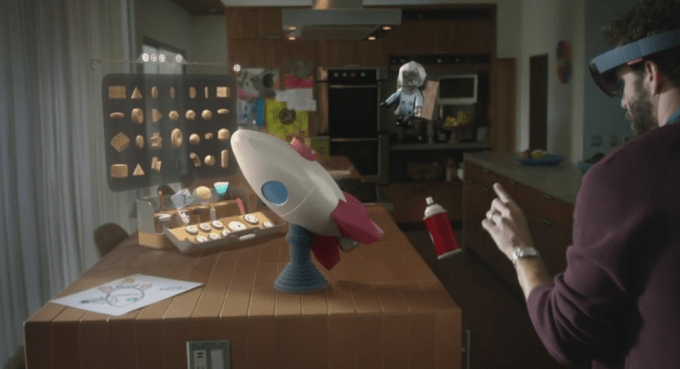
Despite giving no information about release date, price, or technical specs, Microsoft surprised many tech bloggers today with the announcement of Windows Holographic and the HoloLens, an operating system and headset for augmented reality computing.
That is to say that it blends the world around you with digital objects and interfaces. Need to make some last-second modifications to a 3D model that’s going to be 3D-printed this afternoon? In a few years, Microsoft wants you to put on a HoloLens and interact directly with the model, seemingly resting on the empty space on your desk. The tool tray you use won’t just be a few columns of brush and cursor icons, but an actual rack of brushes sitting next to the model you’re working on.
While some have questioned whether or not the HoloLens is actually taking advantage of holograms to power its display, they’re kind of missing the point. Thanks to popular fiction like Star Wars and hologram-enabled stunts like having Tupac and Michael Jackson perform “live” posthumously, people “get” holograms: fancy projections that make it look like something is there without a display, smoke, or mirrors.
When you look through HoloLens, you’re not just going to see an overlay of notifications and command prompts. You’ll see your living room or office, but there will be a digital calendar floating where you traditionally would have had a real one or an 85-inch screen on the open patch of wall where the TV would have hung.
Instead of designing interfaces around anachronistic metaphors based on office desktops in the 1980s or within the constraints of a ~5-inch screen, HoloLens apps can be as literal as they need to be, from simple projections of something on your PC monitor to a reminders screen that takes up an entire wall so that you absolutely can’t miss it.
As far as most people are concerned, calling those interface elements “holograms” is the best way to get the point across without completely alienating them. Saying “Well actually, it’s augmented reality,” is pointless. “Augmented reality” is gibberish, technical jargon that’s about as accessible as calling a wrist watch part of the “Internet of Things.”
In the same way that Apple concocting the term “Retina” to quickly convey the advantages of HiDPI screens (“You can’t even see the pixels!”), “hologram” is just a consumer-friendly way of describing what makes the HoloLens so interesting.
With HoloLens, Microsoft and developers will have to sell consumers on applications that seemingly exist in the same 3D space we live in. It’s a huge change in paradigm to move from from flat/layered applications to interfaces with depth and contextual awareness. Microsoft needs to do everything it can to get developers and consumers on the same page in terms of expectations so that people don’t give up on HoloLens as just another face computer.
After all, it’s 2015 and many are only just realizing that you can in fact be productive on a device without a dedicated keyboard and pointing device because the desktop was the only viable computing environment for so long. People are going to freak out again when you take away screens and input devices completely. By filtering the concept of augmented reality down to something more understandable, Microsoft makes it more appealing to the mass audience needed to make a platform interesting to developers in the first place.
Microsoft doesn’t want to sell you a better Google Glass. They want to sell you Tony Stark’s setup:
No comments:
Post a Comment